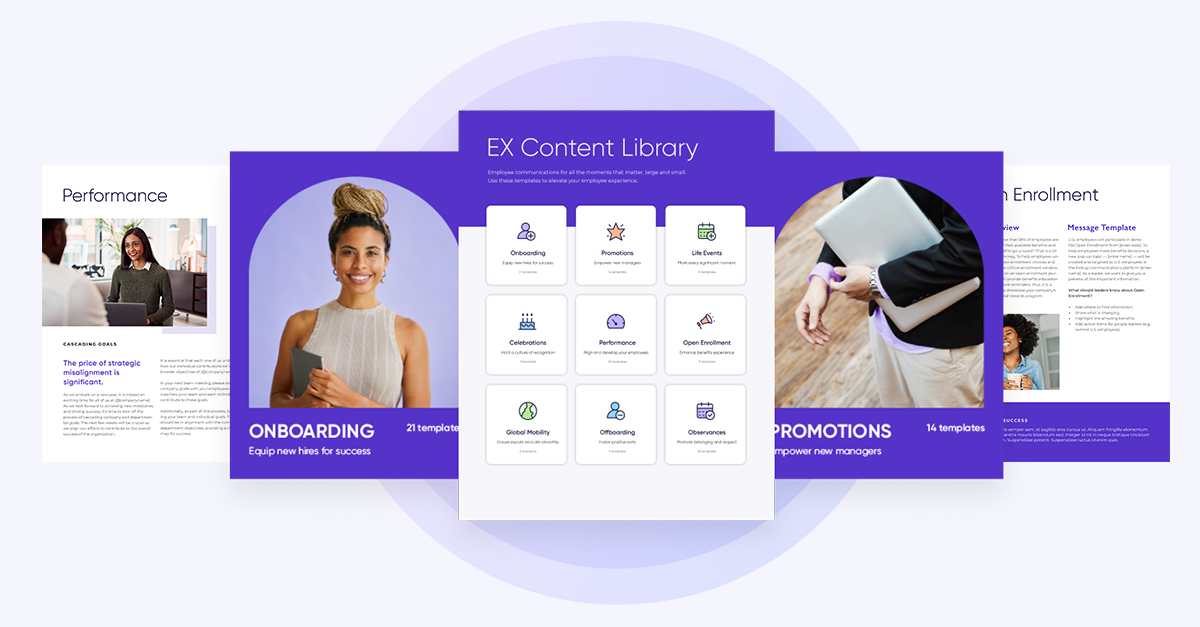Last year, we blogged about what makes a successful multi-dimensional communications strategy. Since then we have not only learned from our customer’s success but also from IT, HR, and Communication professionals on how technology trends and digital initiatives are impacting internal communication strategies at organizations.
We know that a good communication strategy can help increase employee morale, engagement, and align employees with an organization’s vision and mission. We took what we have learned in the past year and created the updated list of eight key components to a successful communications strategy.
1. Understand your communication challenges
As a first step, identify what communication challenges your team and organization face. For global organizations, reaching all employees can be a primary challenge. For others, employees may be constantly bombarded with messages and important company information is not getting seen.
2. Examine your employee audience
Consider the different audiences and groups of employee you need to reach and what tools you have available to reach them. Keep in mind that each employee has a preferred method of consuming news and information – and not all employees may have access to a computer or even company email. For example, if you have a large group of employees who do not have a company email address, your employee communication plan should include alternative channels, such as mobile app, digital signage, etc.
Also, take a page from Marketing, and study your employees and their journey, much like you would a customer. Use our template to form employee personas, so you can target and personalize communications that are relevant and timely to your customer segment. This step will greatly improve the employee experience from day one.
3. Set goals And KPIs
Setting goals for your internal communications strategy are important for measuring the success of your program. By establishing clear goals (that tie to larger business objectives) at the beginning of your process, you will be able to directly see how your communication plan plays out. Consider the different types of audiences you are engaging with as each group of employees may need different goals. For example, you may have different goals for your sales team compared to the employees who are in your retail stores. Remember to adjust your strategy based on what you learn, but keep an eye on the big picture.
4. Choose a workforce communications platform
Once you have established goals, consider what methods of communication you will use to get your message across. Keep in mind the different types of employees you’re reaching and think of what channels will be best for each group.
A multichannel or omnichannel approach is ideal for reaching different employee segments, such as knowledge workers at headquarters to distributed worker across the globe to frontline teams. This method reaches employees on their preferred channels, and the best way to do this is with a workforce communications platform that integrates all your channels into one place to plan, create, publish, and measure your comms.
5. A system of record for communications
It’s best practice to use your workforce communications platform as the source of all company news and information. Then, you can then feed into other channels such as email, mobile app, digital signage, and company intranets. For example, your internal communications team may direct employees to their mobile communication platform as the source for all the information they need to know.
6. Create engaging content
Once you have established your challenges and what communication channels will be used, focus next on creating compelling content. Good content is short and varied. Content can come from a variety of sources such as videos, photos, podcasts, blog posts, stats and data, the intranet and more.
A good content strategy involves pulling content internally, from outside sources and from your own employees. Our customers have noticed that the most engaging content either is employee-submitted or about another employee. People love to celebrate the successes of their peers! It’s important to be open to feedback in order to continually improve your strategy. Remember to also optimize your content for viewing on mobile devices.
7. Utilize mobile communication
Mobile communication platforms are quickly becoming the preferred method of communication for employees simply because they are already using mobile to communicate in their personal lives. Internal communication professionals are on board, in fact, 86% said that a mobile app would be more effective than the tools they already use.
Using a mobile communication platform in your internal communications strategy will help to reach all employees and deliver content directly to their mobile devices.
8. Analyze metrics
Metrics are an important component of measuring the success of your internal communication strategy, but not all metrics are created equal – it is important to understand which metrics are providing you with the most meaningful data. According to our Internal Communicator Index, a startling 85% of respondents said that it’s a challenge to measure whether internal communications have a positive effect on employee engagement.
Find the metrics that are most aligned with your established goals and KPIs and listen to the data. Often, communicators have hunches or assumptions of what kind of communications employees want to hear but only the data will prove that.
Conclusion
These eight steps will help you build a solid foundation for your internal communication strategy. Once you understand your communication challenges, you can set goals that will help you to share engaging content and utilize effective mobile communication. Taking what we have learned in the past year, our improved list of multi-dimensional communication strategies will help you better connect with your employees to give them the news and information they need to thrive.
To learn more about how Firstup is helping organizations improve their internal communication strategies, request a demo of our platform today.





